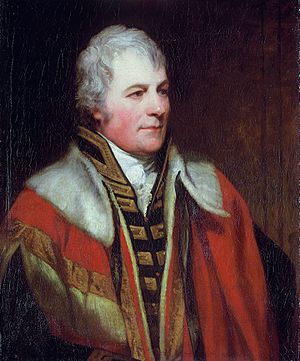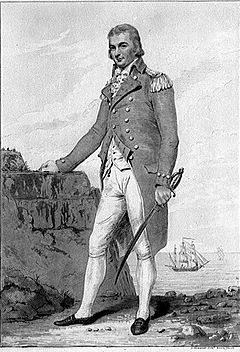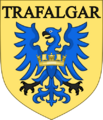William Carnegie, 7th Earl of Northesk facts for kids
Quick facts for kids
The Earl of Northesk
|
|
|---|---|

William Carnegie, 7th Earl of Northesk
|
|
| Born | 10 April 1756 Hampshire, England |
| Died | 28 May 1831 (aged 75) Westminster, England |
| Allegiance | |
| Service/ |
|
| Rank | Admiral of the Red |
| Commands held | HMS Blast HMS Saint Eustatius HMS Enterprise HMS Heroine HMS Beaulieu HMS Andromeda HMS Monmouth HMS Prince HMS Britannia Plymouth Command |
| Battles/wars | American Revolutionary War |
| Awards | Knight Commander of the Order of the Bath |
Admiral William Carnegie, 7th Earl of Northesk (born April 10, 1756 – died May 28, 1831) was a brave British naval officer. He served in three big wars: the American Revolutionary War, the French Revolutionary War, and the Napoleonic Wars.
One time, while he was in charge of HMS Monmouth, he got caught in a big sailor protest called the Nore Mutiny in 1797. The sailors chose him to take their requests directly to George III, the King. He is most famous for being the third-in-command of the Mediterranean Fleet at the famous Battle of Trafalgar. He fought in this battle aboard HMS Britannia. Later in his life, he became a high-ranking admiral and led the Plymouth Command.
Contents
Early Life and Family
William Carnegie was born in Hampshire, England, on April 10, 1756. His father was also an admiral, George Carnegie, 6th Earl of Northesk. His mother was Lady Anne Leslie. William was their second son.
Carnegie joined the Royal Navy in 1771 when he was about 15 years old. His first ship was HMS Albion. He then served on other ships like HMS Southampton and HMS Squirrel. On Squirrel, he sailed all the way to Jamaica in 1774.
In 1777, he became a lieutenant on HMS Apollo. After almost two years, he joined HMS Royal George. This ship was part of a fleet sent to help the city of Gibraltar, which was under attack.
Battles and Promotions
On the way to Gibraltar, Carnegie's fleet captured many Spanish ships on January 8, 1780. Then, on January 16, they fought the Battle of Cape St. Vincent. This battle helped clear the way for the British fleet to reach Gibraltar safely on January 25.
Soon after, in 1780, he joined HMS Sandwich. On April 17, Carnegie was part of the Battle of Martinique. During this fight, Sandwich bravely fought against three enemy ships by itself for a long time. Because of his excellent service in this battle, Carnegie was promoted to commander. In 1781, he took command of his first ship, the fire ship HMS Blast. He later commanded HMS Saint Eustatius.
Becoming a Post-Captain
On April 7, 1782, Carnegie was promoted to post captain. This was a very important rank. He took command of the frigate HMS Enterprise. On October 4, Enterprise captured an American privateer ship called Mohawk.
When the American Revolutionary War ended in 1783, Carnegie brought Enterprise back to England. He was then out of work for a while. In 1788, his older brother died, and William became the heir to his father's title, Lord Rosehill. In 1792, his father passed away, and William became the Earl of Northesk.
The Nore Mutiny
In 1796, Carnegie took command of a new 64-gun ship, HMS Monmouth. His ship was part of the North Sea Fleet. In May 1797, a major event called the Nore Mutiny began. This was a protest by sailors who wanted better pay and conditions.
Carnegie was kept in his cabin by his own crew. On June 6, the mutineers chose him to take their demands to the King. They picked him because they trusted him and knew he cared about sailors. Carnegie agreed to deliver their requests to the Admiralty in London, who then took him to the King. However, the King rejected the demands.
After the mutiny ended, Carnegie left his command of Monmouth. He did not serve on a ship for four years. In 1800, he was given command of HMS Prince. He commanded Prince until 1802. When the war started again in 1803, Carnegie was given command of the large 100-gun ship, HMS Britannia.
Becoming an Admiral
Carnegie was promoted to rear-admiral on April 23, 1804. He kept Britannia as his main ship. In August 1805, his fleet joined other British ships near Cádiz, Spain. Here, a large combined fleet of French and Spanish ships was hiding.
By October, Carnegie was the third-in-command of the Mediterranean Fleet, led by the famous Lord Nelson. On October 21, 1805, the combined fleet sailed out, and the British fleet met them. This led to the historic Battle of Trafalgar.
The Battle of Trafalgar
Nelson planned to break through the enemy fleet in two lines. Britannia was in Nelson's line. Britannia was a slow ship, so Nelson told Carnegie to position his ship where it would be most helpful. Britannia was the fourth ship in Nelson's line to join the fight.
When Britannia broke through the enemy line, it damaged a French 80-gun ship. Then, it fought three enemy ships that were trying to attack Nelson's ship, HMS Victory. Britannia fought bravely throughout the battle. Fifty-two sailors on Britannia were hurt, and ten were killed.
After the British won the battle, a big storm hit. Many captured enemy ships had to be left behind. Carnegie ignored orders to leave the prisoners on a captured ship. Instead, he used Britannia's boats to rescue all the prisoners before sinking the captured ship.
Carnegie continued to serve in the fleet until March 1806. For his bravery at Trafalgar, he received a special award, becoming a Knight Commander of the Order of the Bath. He was also thanked by the British Parliament and the City of London. Carnegie was promoted to vice-admiral in 1808 and then to full admiral in 1814. From 1827 to 1830, he was the leader of the Plymouth Command.
Later Life and Legacy
William Carnegie also had a role in finance. He was the governor of the British Linen Company from 1800 until he died. This company helped develop the economy of Scotland.
He also served as a Scottish representative in the British Parliament of Great Britain. He was elected in 1796, 1802, 1806, and 1830.
Carnegie passed away on May 28, 1831, in London after a short illness. He was buried in the crypt at St Paul's Cathedral, next to famous figures like Nelson and Collingwood. His tomb and a special memorial can still be seen there today.
Family Life
On December 9, 1788, William Carnegie married Mary Ricketts in Paris. She was the niece of another famous admiral, Lord St Vincent. They had nine children together:
- Mary Carnegie (1789–1875)
- Midshipman George Carnegie, Lord Rosehill (1791–1807), who was lost at sea on HMS Blenheim
- Anne Letitia Carnegie (1793–1870)
- William Hopetoun Carnegie, 8th Earl of Northesk (1794–1878)
- Elizabeth Margaret Carnegie (1797–1886)
- Jane Christian Carnegie (1800–1840)
- John Jervis Carnegie (1807–1892)
- Georgina Henrietta Carnegie (1811–1827)
- Admiral Swynfen Thomas Carnegie (1813–1879)
Images for kids



